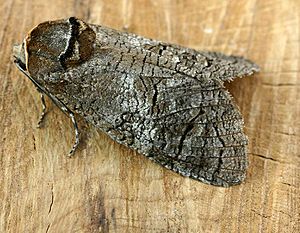List of moths of Great Britain (Cossidae) facts for kids
The family Cossidae is a group of moths often called "leopard and goat moths." These names come from their unique patterns and sometimes strong smells! In Great Britain, you can find three special types of these moths. They are known for their caterpillars, which live inside trees and eat the wood.
Contents
Meet the Leopard and Goat Moths!
Cossidae moths are a fascinating group of insects. Unlike many moths that feed on nectar, the adult Cossidae moths usually don't eat at all! They live for a short time, just long enough to find a mate and lay eggs. Their caterpillars, however, are very hungry and spend a long time growing inside trees.
What Makes Them Special?
These moths are often quite large and have strong, sturdy bodies. Their wings can be patterned with spots, like a leopard, or have more subtle markings. One interesting fact about some of these moths, like the goat moth, is that their caterpillars can smell a bit like goats! This smell might help protect them from predators.
Types of Cossidae Moths in Britain
In Great Britain, we have three main species from the Cossidae family. They are divided into two smaller groups called subfamilies:
Zeuzerinae Subfamily
This group includes two of the British Cossidae moths:
- Phragmataecia castaneae, also known as the reed leopard. This moth is quite rare and mostly found in the east and south of Britain. It's listed in the Red Data Book, which means it needs special protection. Its caterpillars live inside the stems of large plants like reeds.
- Zeuzera pyrina, or the leopard moth. This moth gets its name from its white wings covered in dark blue or black spots, just like a leopard's coat! You can find it in the east, south, and central parts of Britain. Its caterpillars tunnel into the wood of many different kinds of trees.
Cossinae Subfamily
This group has one well-known British species:
- Cossus cossus, famously called the goat moth. This moth is found throughout Britain, though it's considered nationally scarce in some areas. The caterpillars of the goat moth are very large and can spend several years living inside the trunks of trees, eating the wood. They are known for their strong, musky smell.
Life Cycle of Cossidae Moths
The life cycle of these moths is quite interesting, especially because their caterpillars spend so much time hidden away.
- Eggs: Female moths lay their eggs on or near the host plants or trees.
- Larvae (Caterpillars): Once hatched, the caterpillars bore into the stems or trunks of plants and trees. They spend a long time, sometimes several years, eating the wood or plant material. This is where they grow big and strong.
- Pupae: After growing, the caterpillar forms a pupa, often inside its tunnel in the wood or sometimes in the soil nearby. This is a resting stage where it transforms into an adult moth.
- Adults: Finally, the adult moth emerges. As mentioned, these adults usually don't feed and live only for a short period to reproduce.
Where Do They Live?
Cossidae moths live in various habitats depending on their preferred host plants.
- The reed leopard lives in wetlands and marshy areas where reeds grow.
- The leopard moth can be found in gardens, orchards, and woodlands, as its caterpillars feed on many different types of trees.
- The goat moth prefers older woodlands, parks, and even urban areas where there are mature trees for its caterpillars to live in.
Why Are They Important?
These moths, like all insects, play a part in their ecosystem. While their wood-boring caterpillars can sometimes be seen as pests to trees, they are also a food source for birds and other animals. The goat moth is listed in the 2007 UK Biodiversity Action Plan (BAP), which means it's a species that needs help to protect its numbers and habitat. This shows how important it is to look after all kinds of wildlife, even the ones that live hidden away!
See also
- List of moths of Great Britain (overview)


